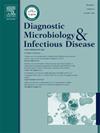Searching for sexually transmitted infections by midstream urine pooling after exclusion of urinary tract infection: A cost-effectiveness analysis
IF 2.1
4区 医学
Q3 INFECTIOUS DISEASES
Diagnostic microbiology and infectious disease
Pub Date : 2025-01-20
DOI:10.1016/j.diagmicrobio.2025.116700
引用次数: 0
Abstract
We aimed to evaluate the cost-effectiveness of screening for sexually transmitted infections (STI), Chlamydia trachomatis, Neisseria gonorrhoeae, Mycoplasma genitalium, and Trichomonas vaginalis in patients with suspected urinary tract infection (UTI) but negative urine cultures, using a pooled sampling method. A cohort of 200 patients was analyzed. A decision tree model based on cost-effectiveness was used to evaluate the following five diagnostic strategies: (A) no screening;(B) screening only men;(C) screening only women;(D) screening men and women with high leukocyte counts (>70cells/µL);(E) screening all men and women. The pooling method reduced reagent testing costs by 75 %. The most cost-effective strategy was screening men and women with high leukocyte counts, yielding an incremental cost-effectiveness ratio of 489.05euros. STI screening using pooled midstream urine samples in patients with suspected UTI and negative urine cultures is cost-effective, particularly when targeting individuals with high leukocyte counts. This approach optimizes resource use and improves early STI detection.
求助全文
约1分钟内获得全文
求助全文
来源期刊
CiteScore
5.30
自引率
3.40%
发文量
149
审稿时长
56 days
期刊介绍:
Diagnostic Microbiology and Infectious Disease keeps you informed of the latest developments in clinical microbiology and the diagnosis and treatment of infectious diseases. Packed with rigorously peer-reviewed articles and studies in bacteriology, immunology, immunoserology, infectious diseases, mycology, parasitology, and virology, the journal examines new procedures, unusual cases, controversial issues, and important new literature. Diagnostic Microbiology and Infectious Disease distinguished independent editorial board, consisting of experts from many medical specialties, ensures you extensive and authoritative coverage.

 求助内容:
求助内容: 应助结果提醒方式:
应助结果提醒方式:


